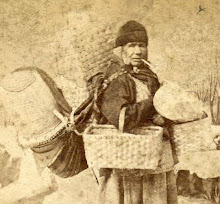
All our Baskets begin their life in the living trees of Oregon White Ash. (Fraxinus latifolia) or Oregon White Ash, grows in abundance in the nearby forests and low woodlands of our northwest community. Not every tree is suitable for making baskets. In fact sometimes only one tree out of a hundred will make a good basket tree. The trees that grow higher in the forest we harvest in the summer months, and the one's that are down low near our home we harvest in the fall. One tree will make approximately 10 good baskets, with the core of the tree set aside for making basket handles.
When harvesting Ash for basketry we honor our Indigenous Traditions. We spend a long time "visiting" with the trees before we cut and take only what we can process that season. We are thankful for the weaving materials that will come, and honor the chosen tree by leaving a gift of tobacco, a feather, coin, or sage before we leave the forest. Oregon Ash regenerate itself, which means that new trees will grow back from the place we cut ~ just like Alder or Big Leaf Maple.
Only about 6 feet of the tree trunk will be used for making baskets. This trunk will be stripped of its outer bark, down to the smooth buckskin of the tree. We soak our tree in an old bathtub for a least a week or two before we began to harvest the splints. Then the real work begins. Each log/trunk is pounded repeatedly to loosen the growth rings. I tell my students to imagine bubble wrap between each growth ring, and when they pound the tree log ~ the bubble wrap pops. We take 1 to 2 inch wide strips of each growth ring and then pound again until we get the log down to about 4 inch in diameter. We save that for making handles.
I bundle up the splints and let them dry. We call these billets. Later when I am ready to make baskets, I will soak the billets in warm water, and separate them in half. When you are done you will have double the amount of splints, each with a smooth shiny side and a rough fuzzy side that we scrape clean with a knife. Then you roll up all the clean separated splints to save for later or you get ready to size and cut them now for weaving.
When harvesting Ash for basketry we honor our Indigenous Traditions. We spend a long time "visiting" with the trees before we cut and take only what we can process that season. We are thankful for the weaving materials that will come, and honor the chosen tree by leaving a gift of tobacco, a feather, coin, or sage before we leave the forest. Oregon Ash regenerate itself, which means that new trees will grow back from the place we cut ~ just like Alder or Big Leaf Maple.
Only about 6 feet of the tree trunk will be used for making baskets. This trunk will be stripped of its outer bark, down to the smooth buckskin of the tree. We soak our tree in an old bathtub for a least a week or two before we began to harvest the splints. Then the real work begins. Each log/trunk is pounded repeatedly to loosen the growth rings. I tell my students to imagine bubble wrap between each growth ring, and when they pound the tree log ~ the bubble wrap pops. We take 1 to 2 inch wide strips of each growth ring and then pound again until we get the log down to about 4 inch in diameter. We save that for making handles.
I bundle up the splints and let them dry. We call these billets. Later when I am ready to make baskets, I will soak the billets in warm water, and separate them in half. When you are done you will have double the amount of splints, each with a smooth shiny side and a rough fuzzy side that we scrape clean with a knife. Then you roll up all the clean separated splints to save for later or you get ready to size and cut them now for weaving.


No comments:
Post a Comment